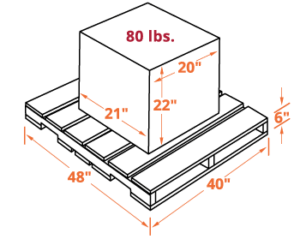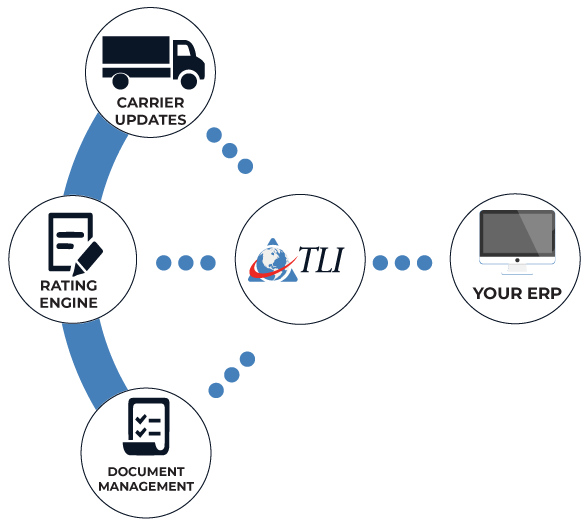What Is a Dimensionalizer?
Why It Matters Now More Than Ever
Starting
July 19, 2025, the
NMFTA is making a big change. The freight class system for LTL shipments will shift significantly more to a
density-based model. That means weight per cubic foot will
determine your freight class—not just the type of product you ship. This is not a new change across the board, the 11-subprovision density scale has been expanded. The new 13-subprovision freight class scale includes more refined density categories.
Here’s how it breaks down:
- Less than 1 PCF: Class 400
- 1 to 2 PCF: Class 300
- 2 to 4 PCF: Class 250
- 4 to 6 PCF: Class 175
- 6 to 8 PCF: Class 125
- 8 to 10 PCF: Class 100
- 10 to 12 PCF: Class 92.5
- 12 to 15 PCF: Class 85
- 15 to 22.5 PCF: Class 70
- 22.5 to 30 PCF: Class 65
- 30 to 35 PCF: Class 60
- 35 to 50 PCF: Class 55
- 50+ PCF: Class 50
This scale creates more precise classifications. It ensures fair pricing across all density levels. Shippers curious about changes can assess their historical
freight’s PCF to investigate how it aligns with the new density structure.
Even a one-inch error in your shipment size can trigger a new class—and a higher bill, with a reclassification fee. If you're not ready for this change, you risk thousands in unnecessary costs. This is where a dimensionalizer saves the day. It calculates density instantly and accurately. That helps you quote shipments correctly, get fewer re-bills, and stay compliant.
Manual measurements won’t cut it anymore. You need precision, and ideally this needs to be delivered swiftly as you are processing each order. So, you really need automation. You need a dimensioner.
Which Shippers Benefit the Most?
The NMFC codes are changing. Most updates adjust existing codes rather than creating new ones. These changes affect how freight is classified—and how much you pay.
Shippers can rely on TLI to manage these updates. You don’t need to track every change yourself. We handle that for you. Staying current with NMFC codes means fewer billing errors and lower shipping costs.
Not every shipper has the same needs with these NMFC changes. But some will see huge benefits from a dimensioner right away.
If you ship small packages in high volume, especially with mixed commodities, you’re a perfect candidate. The more variation you handle, the more valuable automation becomes.
Shippers with bulky or irregular freight (like furniture, auto parts, or building materials) also gain a lot. These items are hard to measure by hand, and their odd shapes make density calculation tricky. A dimensionalizer handles them in seconds.
If your shipment meets three basic conditions, the NMFC applies a 13-level density scale:
- It can be handled with standard equipment.
- It fits easily in a truck without wasting space.
- It poses little or no risk during transit.
When those rules apply, density decides your freight class. But if your freight is fragile, awkward, or hazardous, special classes still apply.
If you’re routing 30+ shipments a day, this tool will save hours in processing time. And when the
new NMFC rules
hit? You’ll already be ahead of the curve.
Save Money and Cut Disputes
Billing disputes are a huge pain. A carrier says your pallet was bigger than reported. You disagree. The result? Reclassification, chargebacks, and frustration.
With a dimensioner, that problem goes away. It scans and saves exact dimensions. Some models even take photos of the freight, which help during invoice disputes or damage claims.
Precise data reduces billing disputes and improves trust with your carriers. And when you know your freight class is right, you can even negotiate better rates.
Less time arguing over accessorials. More time shipping freight. That’s a win.
A dimensionalizer doesn’t just measure. It
automates your whole dimensioning and weighing process. And when partnering with TLI it can integrate into ViewPoint TMS.
It connects to scales, cameras, and software. The system captures every shipment’s size and weight instantly. No delays. No second guessing.
TLI’s partner products integrate directly with our
transportation management system. That means shipment data flows into your TMS automatically, speeding up load building, quoting, and order entry.
You save time. You avoid errors. You move faster. It’s automation that pays for itself.
What is the manual solution?
The LTL PCF formula is:
Density = TotalWeight / ((Length x Width x Height) / 1728) * Quantity)
HOW TO MEASURE PCF IN NONPALLETIZED FREIGHT
EXAMPLE: If the length is 40 inches, the width is 48 inches and the height is 60 inches, multiply them as follows:
- 40 X 48 X 60 = 115,200 cubic inches
- Convert cubic inches to cubic feet by dividing the cubic inch total by 1,728 - the number of cubic inches in one cubic foot.
- For example: 115,200 divided by 1,728 = 66.67 cubic feet.
- Dividing the weight of the shipment by the number of cubic feet will provide the density.
- For example: 250 pounds divided by 66.67 cubic feet = 3.74 pounds per cubic foot.
HOW TO MEASURE PCF IN PALLETIZED FREIGHT
EXAMPLE: If the pallet is 48 inches long, 48 inches wide and 24 inches high, add the height of the pallet (6 inches) to the height of the shipment (24 + 6) for a combined height of 30 inches.
- 48 X 48 X 30 = 69,120 cubic inches
- Next, convert the inches total to cubic feet by dividing 69,120 by 1,728 = 40 cubic feet.
- The density then equals the weight 525 (495 pounds for the shipment and approximately 30 pounds for the pallet) divided by the cubic dimension:
- 525 divided by 40 = 13.13 pounds per cubic foot.
Automate Freight Class Selection
Choose the Right Dimensionalizer
There’s no one-size-fits-all tool. That’s why
TLI's partnership offers
three options
to match your freight:
- Parcel Dimensionalizer – For small boxes and high-volume shipping lines.
- Pallet Dimensionalizer – For standard LTL freight and warehouse use.
- Pallet XL Dimensionalizer – Ideal for long freight or oversized items.
Each tool helps you avoid NMFC reclassification issues. And each one can feed data directly into ViewPoint TMS for seamless automation.
If you’re routing high volumes daily, this investment will pay for itself fast.
Dimensionalizers give you the power to measure accurately and quote with confidence. You avoid surprise fees, streamline order entry, and get ahead of the NMFC changes coming in July 2025.
TLI has secured vendor discounts for our customers and can help you choose the best product for your needs. Similarly we can take your historical NMFC data to route it against the July changes so you know what the price impact or savings will be ahead of time. This will improve your transportation spend budgetary planning.
Let us know if you want more information. We’ll help you find the right solution—and make sure your team is ready for what’s next.
Frequently Asked Questions to TLI About NMFC Updates
What happens if I ship multiple commodities on the same pallet?
NMFC rule changes are not within the scope of Docket 2025-1.
Mixed article freight routing has been a topic of confusion for many shippers, this is a great question. For shipments with multiple handling units, density is calculated per unit unless total weight and dimensions are provided. This flexibility ensures accurate freight classification.
Item 110 Sec. 8. (d) states: “Unless otherwise provided, where a shipment consists of multiple handling units the density shall be calculated on each handling unit, except that where shipping papers show only a total weight for all handling units tendered the density may be calculated by using the total weight and the total cube.”
Will FAKs protect me from these changes?
FAKs (Freight All Kinds) agreements, negotiated between TLI and carriers, are not affected by the NMFC updates. TLI actively monitors FAK agreements to ensure continuity of the FAK for clients. We have analyzed our customers NMFC price impacts, and on a few key accounts we are indeed deploying FAKs to protect them. If a carrier seeks to change an existing FAK agreement, or reformat their existing class structure we will promptly discuss this request with you. If you are interested in working with TLI for the first time, please let us have some historical data to see if this solution makes sense for your shipper profile.
How can I avoid reclassification charges?
Simply entering accurate dimensions and weights is key. ViewPoint TMS automates this process, minimizing the risk of errors and reclassification fees.
Do I have to use NMFC codes?
TLI has alternative contract types that can be used to route LTL freight with carriers, however this is largely determinant around the shippers historical data. If for example you are routing freight to a consistent destination than we can acquire point-to-point pricing, and we also have shippers using strictly density based pricing, and linear feet contracts as well. Please let us know if you would like to explore an alternative LTL option.






